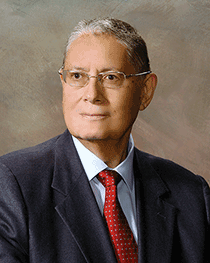CMU alumnus J. Renato Iturriaga was at the forefront of the computer revolution
The first time J. Renato Iturriaga stood in front of the IBM 650, he had no idea that the encounter with the world’s first mass-produced “thinking machine” would alter the course of his professional life.
It was 1958. Sir Edmund Hillary had reached the South Pole; the first successful American satellite, Explorer 1, had been launched into orbit; and Cuba was falling to the revolutionary forces of Fidel Castro. Yet there was something perhaps more profound happening, even if it wasn’t grabbing headlines. It was a revolution, of sorts—a shift in how the human thought process was studied. It would marry artificial intelligence and cognitive science and eventually catapult computer science to the global stage.
Iturriaga was then 17 years old and an undergraduate at the Universidad Nacional Autónoma de México (UNAM) studying astronomy, mathematics, and physics. The IBM 650 encounter occurred during his work as a research assistant for one of Mexico’s most prominent astronomers, Arcadio Poveda. Iturriaga was helping him to develop a method to calculate the mass of elliptical galaxies by mapping out the orbital motion of the stars.
“My job was to work on an Olivetti machine calculating the trajectory of the stars in a galaxy. I would spend my afternoons making calculations on an Olivetti machine that would slowly go chaca, chaca, chaca.”
That routine came to an end when Poveda arrived at the office one day and told Iturriaga about an “electronic brain” arriving at UNAM. He wanted Iturriaga to check it out, telling him, “I think it can help us trace the orbits of the stars.”
The only student among scientists and professors, Iturriaga—following Poveda’s directive—sat in the programming course of the IBM 650, the first to take place south of the Rio Grande. He had no idea what to expect. “It was a wonderful surprise when I understood the logic of programming: I tell the machine what to do, and it obeys me and does what I instructed. Obviously, I also learned that if I made a mistake and gave it the wrong instruction, the machine would do something absurd or would do nothing.”
Iturriaga says his eureka moment in the IBM 650 class came when he grasped that computers could generate or alter their own instructions, contrary to the Olivetti. “There it was, the essence of these learning machines and artificial intelligence. To advance in this direction became, and still remains, an intellectual challenge.”
In the spring of 1959, Alan Perlis, the newly appointed head of Carnegie Mellon’s Computation Center, attended a UNAM computer applications seminar. Three years prior, CMU had purchased its first computer, also an IBM 650, installing it in the basement of the business school. Iturriaga also attended the UNAM seminar and met Perlis, who was to become an integral part of his future. That summer, as part of an agreement between the two universities to exchange programmers, an assistant to Perlis headed south to Mexico and Iturriaga headed north to Pittsburgh for their respective internships.
 Perlis had a plan for keeping Iturriaga busy during his three-month stay at CMU. “He gave me this problem so I—a junior with what he thought was not much mathematic training—would entertain myself for the next three months. For some reason, I understood what the problem was about; I resolved it in two days.” When Iturriaga handed Perlis the solution, the professor burst into surprised laughter. He then became Iturriaga’s mentor.
Perlis had a plan for keeping Iturriaga busy during his three-month stay at CMU. “He gave me this problem so I—a junior with what he thought was not much mathematic training—would entertain myself for the next three months. For some reason, I understood what the problem was about; I resolved it in two days.” When Iturriaga handed Perlis the solution, the professor burst into surprised laughter. He then became Iturriaga’s mentor.
Encouraged by Perlis, Iturriaga no longer pursued an astronomy career; he returned to CMU in the fall of 1963 and entered the circle of what he reverently calls “the big three” professors—Perlis (S’42), Herbert Simon (CMU’90), and Allen Newell (TPR’57). He says new ideas were floating around daily. “At Carnegie Mellon, I glimpsed the future. These three intellectual giants were the founding fathers of computer science. It was a delicious way to learn.”
Perlis, Newell, and Simon certainly have the hardware to back up Iturriaga’s perspective. Perlis, a computer scientist known for his pioneering work in programming, was the first recipient of the Turing Award in 1966, considered to be the Nobel Prize of computer science. Simon was one of the most influential social scientists of the 20th century and one of the founders of artificial intelligence; he was the winner of the 1978 Nobel Prize in Economics and was also a 1975 Turing Award recipient, received jointly with Newell, a pioneer in cognitive science who gained an international reputation, like his two colleagues, as one of the founders of artificial intelligence.
Studying computer science at CMU, Iturriaga (S’64,’67) earned his PhD in computer science the same year that both Bill Gates and Steve Jobs had their 12th birthdays. Randy Bryant, dean of CMU’s School of Computer Science, affectionately refers to Iturriaga as “serial number one” because he was the college’s “first computer science alumnus.”
He has put his degree to good use. Recently, he was appointed as the liaison between the Federal Ministry of Education and the governor of the State of Morelos, Mexico. The Cuernavaca, Mexico resident has also held top positions in the country’s higher education, corporate, and government sectors. As a professor at UNAM, he founded and headed the Center for Applied Mathematics and Systems. In addition, he has worked at Banamex, the largest Mexican bank and has held executive positions in numerous Mexican government agencies.
For his impactful career, Iturriaga was a recipient of CMU’s 2013 Alumni Distinguished Achievement Award.



